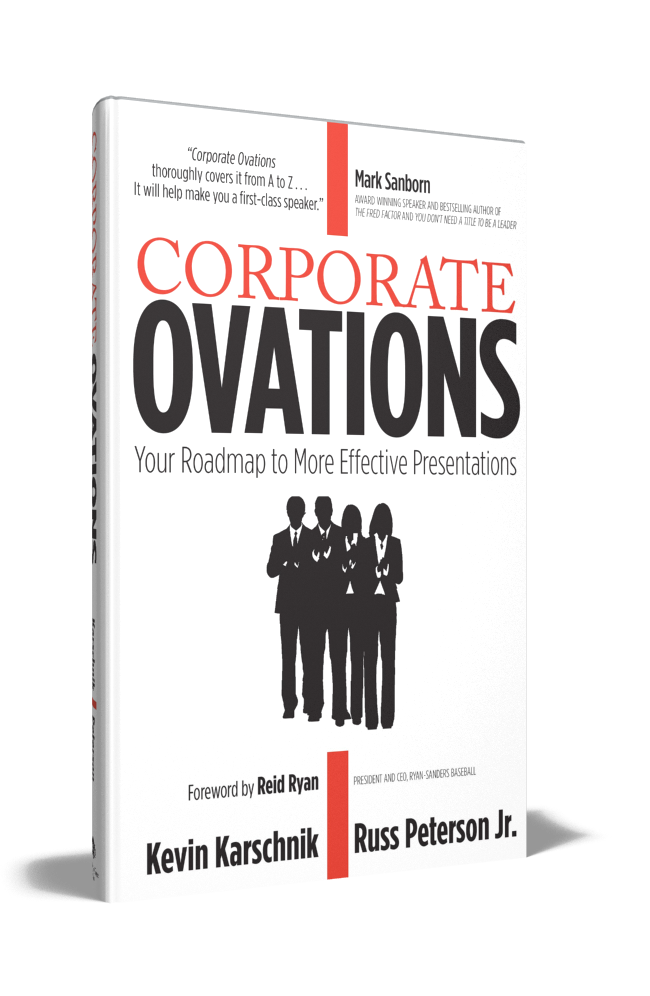The audience began to shift in their seats at the 5 minute mark of the presentation. So far the presenter had successfully bored the audience with 6 slides of solid text and a mouthful of insincere pleasantries. After 10 more minutes of words on slides and a presenter reading the slides, two people walked out and several others were jumping on their phones checking email or facebook!

Have you been in this presentation before? The sad truth is that we can all relate because we’ve all been there. And… if we’re all willing to admit it… we’ve probably all been this presenter at some point in our career too.
The Problem
Most presenters claim they don’t have time to create effective presentations so they just do a brain dump of data and information on each slide, never construct an appropriate message, and proceed to read the slides to the audience because there was no rehearsal either.
Audiences check out very quickly and they have every right because it’s obvious the presenter does not respect their time. Our most precious resource is our time. When a speaker delivers a poor presentation like this it becomes obvious she invested none of her own time to make the message more engaging or succinct. She’s too busy and didn’t want to waste her own time, so instead she’s going to waste ours. Nothing could be more rude.
Three-Step Solution
Now maybe the presenter has the time but just doesn’t know what to do. That is fair. Let’s take care of that right now by giving you three simple steps you can implement to create more engaging presentations for your audience.
Audience’s know when the speaker is unprepared. It sends a strong signal to each person in the audience, and most of the time it’s not a good one. Here are three simple tasks you can do to improve your messages.
1. Engage them from the Start
“Hi, my name is Claude Miller. I’m your ABC Sales Rep and today I’m going to tell you about our firm’s history and our service capabilities.” While I’m not going to say this opening to a presentation is absolutely wrong, I will say it could be much improved! This opening gave the audience two things (but not very well). The two items the speaker just offered is a credibility statement (he’s a sales rep) and a preview of the tour he’s about to deliver (history and capabilities.)
The two pieces most business presenters leave out are the two pieces the audience most wants. We call them the Attention and the Audience Benefit.
Attention
There are many ways to gain attention. In a sales presentation you could ask a thought-provoking question you know is on their minds or quote someone in the audience.
“If you had to scale up your distribution in 3 months without increasing costs, where would you start?”
“I was speaking to Jeremy before we started today and he told me…”
Audience Benefit
Deep down we all know our time is our most valuable resource. So when a speaker expects us to sit and listen, we are investing our time. We all want to know what our return on this investment is going to be. As a presenter, offer the benefit (“What’s In It For Me” WIIFM) at the start of your presentation.
“Today you’ll learn more about the finance tools we offer so the next time you need to scale your production lines, you can implement faster.”
2. Build a Structured Message
When the audience cannot follow your message they will get annoyed (because you’re wasting their time) and they will get tired or bored. Either way, each person will begin to check out and focus on something else. The message must have a structure and a flow to it. While there are many ways of structuring different types of messages, one of the most powerful and widely used structures we have found is called What-Why-How.
WHAT – Is the issue? What is the Problem? What is the focus? What is the situation?
WHY – Why did this happen? Why is it happening? Why is it important? Why do we need action now?
HOW – How are we going to move forward? How are we going to correct? How are we going to implement?
3. Build Graphical Slides
The use of pictures is more than just dropping a photo of a smiling customer on a slide with 8 bullets of text. Pictures and graphics with animations can create both focus and simplicity for the audience. The problem with so many slides is the sheer amount of information placed on each slide. The first thing the audience does when they see a new slide is they begin to explore with their eyes.
They are trying to make a discovery. In other words, what am I supposed to look at here and what am I supposed to see? If we cannot get to our first discovery within 3 seconds, we start to get frustrated. You may have been in an audience with a senior executive who felt this frustration and she just shouts out to the presenter, “What am I looking at here?” or “Where am I supposed to be looking?”
Creating a visual representation of your message does not have to be Hollywood production. It doesn’t have to take 3 weeks to create either. There are simple techniques you can implement using builds and animations to guide the audiences focus through the storyline.
You can also engage a company like BrightCarbon to assist in the development of your slide deck or to teach you better design techniques you can do yourself in PowerPoint. I’ve had the pleasure of working with this company before and they are absolutely amazing at what they can create and teach to you.
Don’t let your audience down and don’t waste their time!
Thinking about my next storyline…
Have a great week,
Russ
Books referenced in this post:
Corporate Ovations: Your Roadmap to More Effective Presentations, By Kevin Karschnik and Russ Peterson Jr.
How to Make the Ultimate Sales Presentation, Blog post by Joby Blume, BrightCarbon
Let’s connect…
iSpeak teaches workshops on Professional Selling to help sales leaders gather the most important data and then use that information to create the right message. Are your sales presentations closing eyelids or deals?
Russ Peterson Jr. is the co-founder and Managing Director of iSpeak, Inc. – An award-winning professional development training company. Russ is a speaker, international trainer, and published author on Professional Sales Communication and Business Communication. He delivers workshops, keynotes, and personal communication coaching services to business professionals in the US and around the world. His leadership blog assists leaders in giving voice to their vision. You can connect with Russ directly through Twitter, Facebook and LinkedIn.



Please note: I reserve the right to delete comments that are offensive or off-topic.